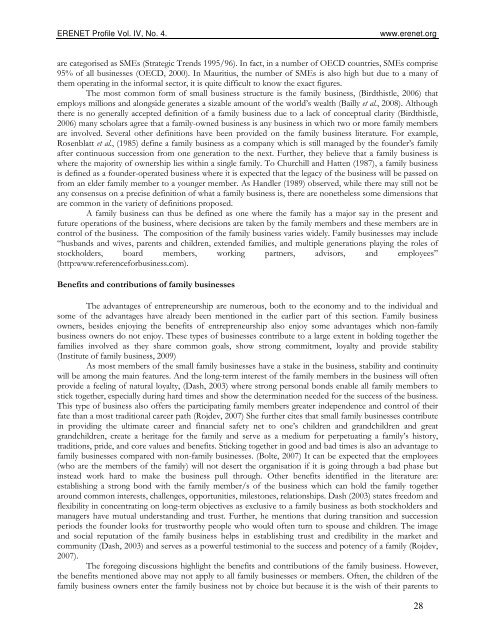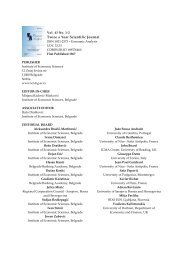Issue 16
Issue 16
Issue 16
You also want an ePaper? Increase the reach of your titles
YUMPU automatically turns print PDFs into web optimized ePapers that Google loves.
ERENET Profile Vol. IV, No. 4.<br />
www.erenet.org<br />
are categorised as SMEs (Strategic Trends 1995/96). In fact, in a number of OECD countries, SMEs comprise<br />
95% of all businesses (OECD, 2000). In Mauritius, the number of SMEs is also high but due to a many of<br />
them operating in the informal sector, it is quite difficult to know the exact figures.<br />
The most common form of small business structure is the family business, (Birdthistle, 2006) that<br />
employs millions and alongside generates a sizable amount of the world’s wealth (Bailly et al., 2008). Although<br />
there is no generally accepted definition of a family business due to a lack of conceptual clarity (Birdthistle,<br />
2006) many scholars agree that a family-owned business is any business in which two or more family members<br />
are involved. Several other definitions have been provided on the family business literature. For example,<br />
Rosenblatt et al., (1985) define a family business as a company which is still managed by the founder’s family<br />
after continuous succession from one generation to the next. Further, they believe that a family business is<br />
where the majority of ownership lies within a single family. To Churchill and Hatten (1987), a family business<br />
is defined as a founder-operated business where it is expected that the legacy of the business will be passed on<br />
from an elder family member to a younger member. As Handler (1989) observed, while there may still not be<br />
any consensus on a precise definition of what a family business is, there are nonetheless some dimensions that<br />
are common in the variety of definitions proposed.<br />
A family business can thus be defined as one where the family has a major say in the present and<br />
future operations of the business, where decisions are taken by the family members and these members are in<br />
control of the business. The composition of the family business varies widely. Family businesses may include<br />
“husbands and wives, parents and children, extended families, and multiple generations playing the roles of<br />
stockholders, board members, working partners, advisors, and employees”<br />
(http:www.referenceforbusiness.com).<br />
Benefits and contributions of family businesses<br />
The advantages of entrepreneurship are numerous, both to the economy and to the individual and<br />
some of the advantages have already been mentioned in the earlier part of this section. Family business<br />
owners, besides enjoying the benefits of entrepreneurship also enjoy some advantages which non-family<br />
business owners do not enjoy. These types of businesses contribute to a large extent in holding together the<br />
families involved as they share common goals, show strong commitment, loyalty and provide stability<br />
(Institute of family business, 2009)<br />
As most members of the small family businesses have a stake in the business, stability and continuity<br />
will be among the main features. And the long-term interest of the family members in the business will often<br />
provide a feeling of natural loyalty, (Dash, 2003) where strong personal bonds enable all family members to<br />
stick together, especially during hard times and show the determination needed for the success of the business.<br />
This type of business also offers the participating family members greater independence and control of their<br />
fate than a most traditional career path (Rojdev, 2007) She further cites that small family businesses contribute<br />
in providing the ultimate career and financial safety net to one’s children and grandchildren and great<br />
grandchildren, create a heritage for the family and serve as a medium for perpetuating a family’s history,<br />
traditions, pride, and core values and benefits. Sticking together in good and bad times is also an advantage to<br />
family businesses compared with non-family businesses. (Bolte, 2007) It can be expected that the employees<br />
(who are the members of the family) will not desert the organisation if it is going through a bad phase but<br />
instead work hard to make the business pull through. Other benefits identified in the literature are:<br />
establishing a strong bond with the family member/s of the business which can hold the family together<br />
around common interests, challenges, opportunities, milestones, relationships. Dash (2003) states freedom and<br />
flexibility in concentrating on long-term objectives as exclusive to a family business as both stockholders and<br />
managers have mutual understanding and trust. Further, he mentions that during transition and succession<br />
periods the founder looks for trustworthy people who would often turn to spouse and children. The image<br />
and social reputation of the family business helps in establishing trust and credibility in the market and<br />
community (Dash, 2003) and serves as a powerful testimonial to the success and potency of a family (Rojdev,<br />
2007).<br />
The foregoing discussions highlight the benefits and contributions of the family business. However,<br />
the benefits mentioned above may not apply to all family businesses or members. Often, the children of the<br />
family business owners enter the family business not by choice but because it is the wish of their parents to<br />
28
















